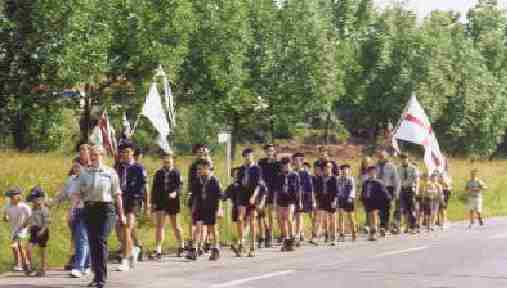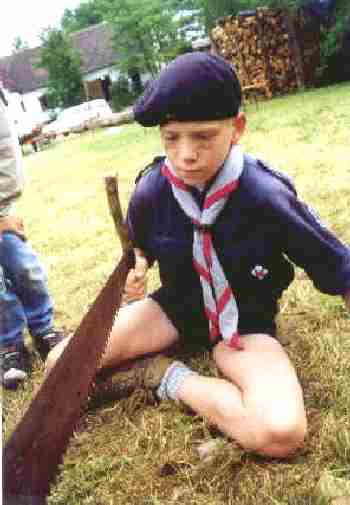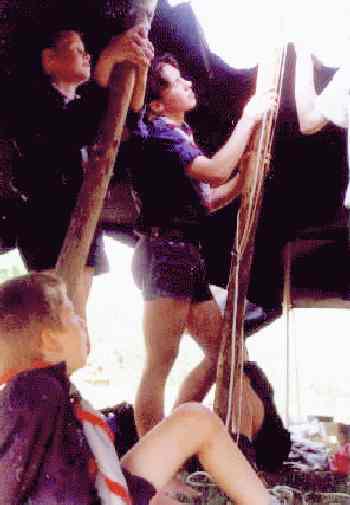
Figure 1.--DPB are Scouts are pictured here on an outing. Note the Cub-age boys at the front, who do not appear to be wearing standardized uniforms. Note that on this outing that the standard headgear appears to be a beret.

The Deutscher Pfadfinderbund is is interdenominational. Both boys and girls participate, but in separated groups. The Guide and Scout Union follows the tradition of the German interdenominational Scout Movement (founded in 1911) and the Girl Guide Movement (founded in 1912). It resulted from a merger of the German Guide Union and the Scout Union on January 1, 1976. The association is open to boys and girls of all spiritual convictions. Scouting within the association is dedicated to life in nature and a consciousness of the social community as well as such activities as sports, craftsmanship and fine arts. Children are given the possibility to develop their own abilities and knowledge and to learn from each other. The group social life, which includes the handicapped and the children of migrant workers, encourages cooperation, tolerance, solidarity, acceptance of responsibility, decisions by concensus and activities. Every four years the association holds a national jamboree which is an occasion for meeting foreign Scout groups. These jamborees each have a central theme which gives them their character. In the 1980s, the concern about ecological matters was reinforced. The ÖkoPfad project (Ecological Way) required all groups to recognize and take responsibility for nature and the environment in practical ways.

Figure 2.--DPB Scouts wear blie shirts, but pants appear to be optional styles. This DPB Scout wears matching blue shorts. Heeadwear is optional. This boy wears a beret. |
The German Scout Federation consists of seperate units for boys an girls as well as Federal Sections linked to the St. George order
for childhood. The German Scouts Federation is:
1. A Scout Federation, which makes the Scout law the basis of its concern, living in the spirit and in the forms of world-wide
brotherhood, looking its way up in a free, world-open humanity.
2. an autonomous federation, with roots in the human rights and in the constitutional structure of our country, dependent from
no one and commited in his actions by conscience and law
3. youth which forms community from personal commitment and conducts its life from own fate, sense of responsibility and truthfulness.
Der Deutsche Pfadfinderbund besteht aus einem Jungenbund, einem Mädchenbund und dem Orden St. Georg über der Jungenschaft als gleichberechtigten Bundesteilen. Jungen und Mädchen bilden getrennte Gruppen.
1. ein Pfadfinderbund, der das Pfadfindergesetz zur Grundlage seines Handelns macht, der im Geiste und in den Formen der weltweiten Bruderschaft lebt und seinen Weg in ein freies, weltoffenes Menschentum sucht;
2. ein autonomer Bund, wurzelnd in den Menschenrechten und in der Grundordnung unseres Landes, von niemandem abhängig und Verpflichtet als unserem Gewissen und Gesetz;
3. bündische jugen, die aus innerer Bindung Gemeinschaft bildet und die ihr Leben aus eignder Bestimmung, vor eigener Verantwortung und mit innerer Wahrhaftigkeit führt.
Die Pfadfinder
at the start of the 20th century, the englishman Robert Baden-Powell founed the Scouting movement. Living in and taking care of nature were for him the priorities. His book "Scouting for boys" spread fast in the
whole world. At the same time an in some ways parallel to scounting arose in Germany the "Wandervogel" (walking bird), which influenced the German youth movement crucially. The life in small's groups "among
friends" with a selected group leader, "primus inter pares" made away with former strict forms of scouting. Much remained however: Scouts traditional clothing, promise, education to responsibility, active commitment, reliability, as well as independent, critical thinking. The Scouts are the largest peace and friendship movement world-wide!
Anfang unseres Jahrhunderts gründete der Engländer Robert Baden-Powell die Pfadfinder. Leben in und Umgang mit der Natur standen für ihn im Vordergrund. Sein Buch "Scouting for boys" verbreitete sich schnell auf der ganzen Welt. Parallel zum Pfadfindertum entstand in Deutschland der Wandervogel, der die deutsche Jugendbewegung entscheidend beeinflußte. Das Leben in Kleingruppen "unter Freunden" mit einem gewählten Gruppenführer, "dem primus inter pares" löste straffe Formen des Scoutismus ab. Viel blieb jedoch: Pfadfinderkluft, Versprechen, Erziehung zu Verantwortlichkeit, aktivem Engagement, Zuverlässigkeit, sowie zu eigenständigem, kritischen Denken. Die Pfadfinder sind die Weltweit größte Friedens- und
Freundschaftsbewegung!
The German Scout Federation was created January 18, 1911 in Berlin. After its prohibition time by the NAZIs it was brought back to
life in 1945 by Walter Jansen (Michael), fisrt under the name "Federation of German Youth", since the allied forbade the name
Scout (pfadfinder). Walter Jansen spent many years in "KZ" (?concentration camp? for his Scouting activities that were
prohibted. The Federation grew fast and even created own refugees homes. Already 1951 the first federal camp took place, since the
federation had expanded far beyond of Berlin boundaries. Today the federation is distributed all over Germany. It counts
roughly 4,000 members, to our understanding the quality having priority to the quantity !
Der Deutsche Pfadfinderbund (DPB) wurde am 18.01.1911 in Berlin gegründet. Nach seiner Verbotszeit durch die Nazis wurde er 1945 durch Walter Jansen (Michael) wieder ins Leben gerufen, erst mit dem Namen "Bund Deutscher Jugend", da die Alliierten den Namen "Pfadfinder" verboten. Walter Jansen hatte dafür, dass er trotz des Verbotes weiterhin
Pfadfinderarbeit machte, jahrelang im KZ gesessen. Schnell wuchs der Bund und führte sogar eigene Flüchtlingsheime. Schon 1951 gab es ein erstes Bundeslager, da sich der Bund weit über Berlins Grenzen hinaus ausgedehnt hatte. Heute ist der DPB über ganz Deutschland verteilt. Er zählt schätzungsweise 4000 Mitglieder, wobei es nach unserem
Selbstverständnis um "gute" Pfadfinder geht, nicht unbedingt um "viele"!
The life of the scouts takes place in small groups, the "Horten". The groups meet once weekly
on evenings at their homes, singing, playing, discussing over nature and scouts techniques
(such as tent installation, orientation, fire techniques, first assistance...) , as well as preparing
travels and many other things. A group consists of approximately 6 - 12 members under an
experienced group leader. Every one or two months the groups are leaving on travel for the
whole weekend . Likewise during most holidays further traveling is undertaken. High point is
a three weeks extended travel during summer holidays, which often leads into other
countries. Every two years at Whitsuntide the whole federation meets to large federal camps.
Das Leben der Pfadfinder findet in kleinen Gruppen, den "Horten" statt. Die Horten treffen sich ein mal in der Woche zu ihren Heimabenden, bei denen gesungen, gespielt, etwas über die Natur und Pfadfindertechniken (wie Zeltaufbau, Orientierung,
Feuertechniken, Erste Hilfe,...) gelernt werden, sowie Fahrten vorbereitet und vieles andere mehr. Eine Gruppe besteht aus etwa 6 - 12 Mitgliedern und wird von einem erfahrenen Gruppenführer geleitet. Alle ein bis zwei Monate gehen die Gruppen
über´s Wochenende auf Fahrt. In den meisten Ferien finden ebenfalls Fahrten stat. Höhepunkt ist eine dreiwöchige "Großfahrt" in den Sommerferien, die oft in andere Länder führt. Alle zwei Jahre Pfingsten trifft sich der ganze Bund zum großen Bundeslager.

Figure 4.--These DPB boys are waiting out a little rainy weather in their tent. |
Boys and girls when the reach 8 years of age can become Scouts. After a probational period the beginner is accepted thru selection by all other members of the group and receives "on loan" his scuff
that he may then wear with the uniform. He promises to obey the basic rules of Scouts. These 10 scout laws cover values like helpfulness, reliability, "chivalry", honesty... The boys remain
often many years in their group. Boys apart from girls, scouts are experiencing life in a community of mixed ages , which has the advantage that the older one worries about the
younger one. A Scout goes through different age levels, not impling any ranking idea. Apart from the current group activities there are some trips reserved only for elder Scouts.
Mit acht Jahren können Jungen und Mädchen Pfadfiner werden. Nach einer Probezeit wird der "Neuling" durch Wahl aller in die Gruppe aufgenommen und bekommt das Halstuch verliehen, das er dann zur Kluft tragen darf. Er verspricht, die Grundregeln der Pfadfinder zu befolgen. Diese zehn "Pfadfindergesetze" umfassen Werte, wie Hilfsbereitschaft, Zuverlässigkeit,
"Ritterlichkeit", Ehrlichkeit... Die Jungen bleiben oft viele Jahre in ihrer Gruppe. Nach geschlechtern getrennt haben wir eine "Erlebnisgemeinschaft Ungleichaltriger", was den Vorteil hat, dass der Ältere sich um den Jüngeren kümmert. Ein Pfadfinder durchlebt verschiedene Reifestufen, die nichts mit einer Rangordnung zu tun haben. Neben den Hortenaktivitäten gibt es Älterenrunden, die sich seperat treffen.
All of the DPB boys wear similar uniforms. HBC is not sure, however, if only the Scouts are pictured here or if DPB Scouts and Cubs have the same uniform.
The DPB Scouts mostly wear a stanadrd blue Scout short, but the rest of the uniform varies considerably.
The standard heagwear in the 1990s appears to be a blue beret. Not all the boys wear the beret, but it appears to be widely worn by some groups.
The standard shirt in the 1990s appears to be a dark blue shirt. Some boys wear khaki or light blue shirts, but by far the most common shirt is the dark blue shirt.
All the DPB boys wear kerchiefs. The color appears to very from troop to troop, but this needs to be confirmed. The boys here wear grey kerchoefs with red stripes.
The DPB Scouts wear a variety of pants. Many boys wear dark blue short pants matching their shirts. Many boys, however, wear a variety of other pants--including sweat pamts and jeans.
DPB boys in the 1990s wear a variety of socks, but all ankle socks. None of the boys wore the traf\ditional kneesocks once worn by Scouts.
Navigate the Historic Boys' Uniform Chronology Pages:
[Return to the Main chronologies page]
[The 1900s]
[The 1910s]
[The 1920s]
[The 1930s]
[The 1940s]
[The 1950s]
[The 1960s]
[The 1970s]
[The 1980s]
[The 1990s]
[The 2000s]
Navigate the Historic Boys' Uniform Web Site:
[Introduction]
[Bibliographies]
[Chronologies]
[Contributions]
[FAQs]
[Garments]
[Organizations]
[Boys' Uniform Home]
Navigate the Historic Boys' Uniform Web organizatiion pages:
[Return to the Main German Scout page]
[Boys' Brigade]
[Camp Fire]
[Hitler Youth]
[National]
[Pioneers]
[Royal Rangers]
[Scout]
